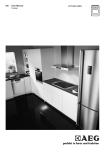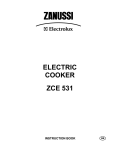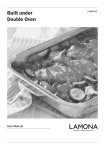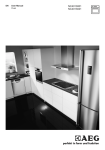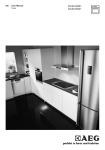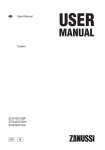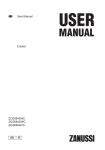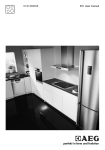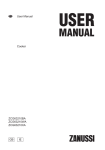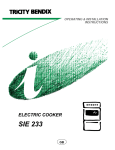Download User manual Oven ZOF35702
Transcript
EN User manual Oven ZOF35702 Contents Safety information _ _ _ _ _ _ _ _ _ _ _ _ _ _ Product description _ _ _ _ _ _ _ _ _ _ _ _ _ Before first use _ _ _ _ _ _ _ _ _ _ _ _ _ _ _ _ Daily use _ _ _ _ _ _ _ _ _ _ _ _ _ _ _ _ _ _ _ Clock functions _ _ _ _ _ _ _ _ _ _ _ _ _ _ _ _ Using the accessories _ _ _ _ _ _ _ _ _ _ _ _ Helpful hints and tips _ _ _ _ _ _ _ _ _ _ _ _ _ 2 4 5 5 7 8 9 Care and cleaning _ _ _ _ _ _ _ _ _ _ _ _ _ What to do if… _ _ _ _ _ _ _ _ _ _ _ _ _ _ _ Installation _ _ _ _ _ _ _ _ _ _ _ _ _ _ _ _ _ _ Environment concerns _ _ _ _ _ _ _ _ _ _ _ GREAT BRITAIN & IRELAND - Guarantee/ Customer Service _ _ _ _ _ _ _ _ _ _ _ _ _ _ 16 18 19 21 21 Subject to change without notice. Safety information Before the installation and use of the appliance, carefully read the supplied instructions. The manufacturer is not responsible if an incorrect installation and use causes injuries and damages. Always keep the instructions with the appliance for future reference. Children and vulnerable people safety Warning! Risk of suffocation, injury or permanent disability. • This appliance can be used by children aged from 8 years and above and persons with reduced physical, sensory or mental capabilities or lack of experience and knowledge if they have been given supervision or instruction for the operation of the appliance by a person who is responsible for their safety. • Do not let children play with the appliance. • Keep all packaging away from children. • Keep children and pets away from the appliance when it operates or when it cools down. Accessible parts are hot. • If the appliance has a child safety device, we recommend that you activate it. • Cleaning and user maintenance shall not be made by children without supervision. Installation Warning! Only a qualified person must install this appliance. • Remove all the packaging. • Do not install or use a damaged appliance. 2 • Obey the installation instruction supplied with the appliance. • Always be careful when you move the appliance because it is heavy. Always wear safety gloves. • Do not pull the appliance by the handle. • The kitchen cabinet and the recess must have suitable dimensions. • Keep the minimum distance from the other appliances and units. • Make sure that the appliance is installed below and adjacent safe structures. • Parts of the appliance carry current. Close the appliance with furniture to prevent touching the dangerous parts. • The sides of the appliance must stay adjacent to appliances or to units with the same height. Electrical connection Warning! Risk of fire and electrical shock. • All electrical connections should be made by a qualified electrician. • The appliance must be earthed. • Make sure that the electrical information on the rating plate agrees with the power supply. If not, contact an electrician. • Always use a correctly installed shockproof socket. • Do not use multi-plug adapters and extension cables. • Make sure not to cause damage to the mains plug and to the mains cable. Contact the www.zanussi.com • • • • • • • Service or an electrician to change a damaged mains cable. Do not let mains cables to come in touch with the appliance door, specially when the door is hot. The shock protection of live and insulated parts must be fastened in such a way that it cannot be removed without tools. Connect the mains plug to the mains socket only at the end of the installation. Make sure that there is access to the mains plug after the installation. If the mains socket is loose, do not connect the mains plug. Do not pull the mains cable to disconnect the appliance. Always pull the mains plug. Use only correct isolation devices: line protecting cut-outs, fuses (screw type fuses removed from the holder), earth leakage trips and contactors. The electrical installation must have an isolation device which lets you disconnect the appliance from the mains at all poles. The isolation device must have a contact opening width of minimum 3 mm. Use Warning! Risk of injury, burns or electric shock or explosion. • Use this appliance in a household environment. • Do not change the specification of this appliance. • Make sure that the ventilation openings are not blocked. • Do not let the appliance stay unattended during operation. • Deactivate the appliance after each use. • Internally the appliance becomes hot when in operation. Do not touch the heating elements that are in the appliance. Always use oven gloves to remove or put in accessories or ovenware. • Be careful, when you open the appliance door while the appliance is in operation. Hot air can release. www.zanussi.com • Do not operate the appliance with wet hands or when it has contact with water. • Do not apply pressure on the open door. • Do not use the appliance as a work surface or as a storage surface. • Always keep the appliance door closed when the appliance is in operation. • Open the appliance door carefully. The use of ingredients with alcohol can cause a mixture of alcohol and air. • Do not let sparks or open flames to come in contact with the appliance when you open the door. • Do not put flammable products or items that are wet with flammable products in, near or on the appliance. Warning! Risk of damage to the appliance. • To prevent damage or discoloration to the enamel: – Do not put ovenware or other objects in the appliance directly on the bottom. – Do not put aluminium foil directly on the bottom of the appliance. – do not put water directly into the hot appliance. – do not keep moist dishes and food in the appliance after you finish the cooking. – be careful when you remove or install the accessories. • Discoloration of the enamel has no effect on the performance of the appliance. It is not a defect in the sense of the warranty law. • Use a deep pan for moist cakes. Fruit juices cause stains that can be permanent. Care and Cleaning Warning! Risk of injury, fire or damage to the appliance. • Before maintenance, deactivate the appliance and disconnect the mains plug from the mains socket. • Make sure the appliance is cold. There is the risk that the glass panels can break. 3 • Replace immediately the door glass panels when they are damaged. Contact the Service. • Be careful when you remove the door from the appliance. The door is heavy! • Clean regularly the appliance to prevent the deterioration of the surface material. • Remaining fat or food in the appliance can cause fire. • Clean the appliance with a moist soft cloth. Only use neutral detergents. Do not use abrasive products, abrasive cleaning pads, solvents or metal objects. • If you use an oven spray, obey the safety instructions on the packaging. • Do not clean the catalytic enamel (if applicable) with any kind of detergent. Warning! Risk of electrical shock. • Before replacing the lamp, disconnect the appliance from the power supply. • Only use lamps with the same specifications. Disposal Warning! Risk of injury or suffocation. • Disconnect the appliance from the mains supply. • Cut off the mains cable and discard it. • Remove the door catch to prevent children and pets to get closed in the appliance. Internal light • The type of light bulb or halogen lamp used for this appliance, is only for household appliances. Do not use it for house lighting. Product description General overview 1 11 11 2 3 4 6 5 4 3 2 1 4 3 2 1 Accessories • Oven shelf For cookware, cake tins, roasts. 4 1 Knob for the top oven functions 2 Knob for the top oven temperature 5 3 6 7 8 9 7 8 10 3 Temperature indicator 4 Electronic programmer 5 Knob for the main oven functions 6 Knob for the main oven temperature 7 Heating element 8 Oven lamp 9 Fan 10 Fan and heating element 11 Shelf positions • Roasting pan grid To put in the deep roasting pan. • Deep roasting pan www.zanussi.com To bake and roast or as a pan to collect fat. Before first use Warning! Refer to "Safety information" chapter. Initial Cleaning • Remove all accessories and removable shelf supports (if applicable). • Clean the appliance before first use. Important! Refer to the chapter "Care and cleaning". Setting the time You must set the time before you operate the oven. When you connect the appliance to the electrical supply or after a power cut, the indicator for the Time of Day function flashes. Press the + or - button to set the correct time. After approximately five seconds, the flashing stops and the display shows the time of day you set. To change the time, press again and again until the indicator for the Time of Day function flashes. You must not set the Duration or End function at the same time. To use the appliance, push the knob. The knob comes out. Preheating Preheat the empty appliance to burn off the remaining grease. 1. Set the function and the maximum temperature. 2. Let the appliance operate for one hour. 3. Set the function and the maximum temperature. 4. Let the appliance operate for ten minutes. 5. Set the function and the maximum temperature. 6. Let the appliance operate for ten minutes. Accessories can become hotter than usually. The appliance can emit an odour and smoke. This is normal. Make sure that the airflow is sufficient. Daily use Warning! Refer to "Safety information" chapter. Cooling fan When the appliance operates, the cooling fan switches on automatically. If you switch off the appliance, the cooling fan continues to operate until the appliance cools down. Activating and deactivating the top oven 1. Turn the knob for the top oven functions to an oven function. 2. Turn the knob for the top oven temperature to a temperature. www.zanussi.com 3. The temperature indicator comes on while the temperature in the appliance increases. To deactivate the appliance, turn the knob for the top oven functions and the knob for the top oven temperature to the Off position. Activating and deactivating the main oven 1. Turn the knob for the main oven functions to an oven function. 2. Turn the knob for the main oven temperature to a temperature. The temperature indicator comes on while the temperature in the appliance increases. 5 3. To deactivate the appliance, turn the knob for the main oven functions and the knob for the main oven temperature to the Off position. Top Oven Functions Oven function OFF position Light Application The appliance is OFF. Use this function to light up the oven interior. Pizza Oven To bake and roast on one oven level at the same time. Decrease the oven temperatures (20-40 °C) compared with Conventional. Thermal Grilling To roast larger joints of meat or poultry on one level. Also to gratinate and brown. Single Circuit Grill Dual Circuit grill Top Heat Bottom Heat Conventional Cooking To grill flat food in the middle of the grill and to toast. To grill flat food in large quantities and to toast. To brown bread, cakes and pastries and for bakes. To bake cakes with crispy or crusty bases and to preserve food. To bake and roast on one oven level. Main Oven Functions Oven function OFF position Light Thermaflow® Defrost Single Circuit Grill 6 Application The appliance is OFF. To light up the oven interior. Roast or roast and bake food at the same cooking temperature on different levels at the same time. To defrost frozen food. To grill flat food in the middle of the grill and to toast. Dual Circuit Grill To grill flat food in large quantities and to toast. Thermal Grilling To roast larger joints of meat or poultry on one level. Also to gratinate and brown. www.zanussi.com Clock functions Electronic programmer 1 2 1 1 Function indicators 2 Time display 3 Button + 4 Selection button 5 Button - 5 4 3 Clock function Time of day Minute Minder Duration End Application To set, change or check the time of day. To set a countdown time. This function has no effect on the operation of the oven. To set how long the appliance must operate. To set when the appliance must be deactivated. You can use Duration and End at the same time to set the time when the appliance must be activated and then deactivated. First set Duration, then End. Setting the clock functions 1. For Duration and End , set an oven function and temperature. This is not necessary for the Minute Minder . 2. Press the Selection button again and again until the indicator for the necessary clock function flashes. 3. Press + or - to set the necessary clock function. The display shows the indicator for the clock function you set. When the set time ends, the indicator flashes and an acoustic signal sounds for two minutes. With the Duration and End functions, the appliance deactivates automatically. www.zanussi.com 7 4. 5. Press a button to stop the signal. Turn the knob for the oven functions and the knob for the temperature to the off position. 2. Press and hold the button -. The clock function goes out after some seconds. Cancelling the clock functions 1. Press the Selection button again and again until the necessary function indicator flashes. Using the accessories Warning! Refer to "Safety information" chapter. Inserting the oven accessories Put in the slide-in accessories so that the double side edges are at the back of the oven and point down to the bottom. Push the slide-in accessories between the guide-bars of one of the oven levels. The deep roasting pan and the oven shelf have double side edges. These edges and the shape of the guide-bars causes the anti-tilt safety for the oven accessories. Inserting the oven shelf and deep roasting pan together Put the oven shelf on the deep roasting pan. Push the deep roasting pan between the guide-bars of one of the oven levels. Grilling set The grilling set includes the roasting pan grid and the deep roasting pan. You can use the roasting pan grid on the two sides. Warning! Risk of burns when removing the accessories from a hot oven. You can use the grilling set to roast larger pieces of meat or poultry on one level: You can use the grilling set to grill flat dishes in large quantities and to toast: Put the roasting pan grid inside the deep roasting pan so that the supports of the oven shelf point upwards. Put the roasting pan grid inside the deep roasting pan so that the supports of the oven shelf point downwards. Put the deep roasting pan in the oven at the necessary level. 8 www.zanussi.com Helpful hints and tips Warning! Refer to "Safety information" chapter. The temperature and baking times in the tables are guidelines only. They depend on the recipes, quality and quantity of the ingredients used. Caution! Use a deep baking tray for very moist cakes. Fruit juices can cause permanent stains on the enamel. Top oven The top oven is the smaller of the two ovens. It has 6 shelf levels. Use is to cook smaller quantities of food. It gives especially good results when used to cook fruitcakes, sweets and savoury flants or quiche. Main oven The main oven is particularly suitable for cooking larger quantities of food. Baking General instructions • Your new oven may bake or roast differently to the appliance you had before. Adapt your usual settings (temperature, cooking times) and shelf levels to the values in the tables. • With longer baking times, the oven can be switched off about 10 minutes before the end of baking time, to use the residual heat. When you use frozen food, the trays in the oven can twist during baking. When the trays get cold again, the distortion will be gone. How to use the Baking Tables • We recommend to use the lower temperature the first time. • If you cannot find the settings for a special recipe, look for the one that is almost the same. • Baking time can be extended by 10-15 minutes, if you bake cakes on more than one level. • Cakes and pastries at different heights do not always brown equally at first. If this occurs, do not change the temperature setting. The differences equalize during the baking procedure. Tips on baking Baking results Possible cause Remedy The cake is not browned sufficiently below Incorrect oven level Put the cake on a lower oven level The cake sinks (becomes soggy, lumpy, streaky) Oven temperature too high Use a lower setting The cake sinks (becomes soggy, lumpy, streaky) Baking time is too short Set a longer baking time Do not set higher temperatures to decrease baking times The cake sinks (becomes soggy, lumpy, streaky) Too much liquid in the mixture Use less liquid. Look at the mixing times, specially when you use mixing machines Cake is too dry Oven temperature too low Set a higher oven temperature Cake is too dry Baking time too long Set a shorter baking time Cake does not brown equally Oven temperature too high and baking time too short Set a lower oven temperature and a longer baking time Cake does not brown equally No equal mixture Put the mixture equally on the baking tray www.zanussi.com 9 Baking results Cake does not cook in the baking time set Possible cause Remedy Temperature too low Use a slightly higher oven temperature setting Top oven more than one is used (e.g. shelf positions 1 and 3) Baking Shelf Positions are not critical but ensure that oven shelves are evenly spaced when Temperature [°C] Approx Cook Time (mins) Biscuits 170 - 190 10 - 20 Bread 200 - 220 30 - 35 Bread rolls/buns 200 - 220 10 - 15 - Small & Queen 160 - 170 18 - 25 - Sponges 160 - 170 20 - 30 - Victoria Sandwich 160 - 170 18 - 25 - Madeira 140 - 150 75 - 90 - Rich Fruit 140 - 150 120 - 150 - Gingerbread 140 - 150 75 - 90 - Meringues 90 - 100 150 - 180 - Flapjack 160 - 170 25 - 30 - Shortbread 130 - 150 45 - 65 - Beef/Lamb 140 - 160 150 - 180 - Chicken 140 - 160 75 - 90 Food Cakes: Casseroles: Convenience Foods Follow manufacturer´s instructions. Fish 160 - 180 20 - 30 Fish Pie (Potato Topped) 170 - 180 20 - 30 Fruit Pies, Crumbles 170 - 190 30 - 50 Milk Puddings 140 - 160 90 - 120 Pasta Lasagne etc. 160 - 180 40 - 50 - Choux 180 - 190 30 - 40 - Eclairs, Profiteroles 170 - 180 30 - 40 - Flaky/Puff Pies 180 - 190 30 - 40 180 - 190 15 - 20 Pastry: Shortcrust: - Mince Pies 10 www.zanussi.com Temperature [°C] Approx Cook Time (mins) - Meat Pies 180 - 200 25 - 35 - Quiche, Tarts, Flans 170 - 190 25 - 50 Scones 210 - 220 8 - 12 Shepard´s Pie 180 - 190 30 - 40 Soufflés 170 - 180 20 - 30 - Baked Jacket Potatoes 180 - 190 60 - 90 - Roast Potatoes 180 - 190 60- 90 - Large 180 - 190 25 - 40 - Individual 200 - 210 Food Vegetables: Yorkshire Pudding: Roasting Meat, Poultry 15 - 25 See roasting chart. Baking Shelf Positions are not critical but ensure that oven shelves are evenly spaced when more than one is used (e.g. shelf positions 1 and 3) Temperature [°C] Approx Cook Time (mins) Shelf Position Biscuits 170 - 190 10 - 20 1 Bread 200 - 220 30 - 35 1 Bread rolls/buns 200 - 220 10 - 15 1 - Small & Queen 170 - 180 18 - 25 1 - Sponges 160 - 175 20 - 30 1 - Victoria Sandwich 160 - 170 18 - 25 1 - Madeira 140 - 150 75 - 90 1 - Rich Fruit 140 - 150 120 - 150 1 - Gingerbread 140 - 150 75 - 90 1 - Meringues 90 - 100 150 - 180 1 - Flapjack 160 - 170 25 - 30 1 - Shortbread 130 - 150 45 - 65 1 - Beef/Lamb 150 - 170 150 - 180 1 - Chicken 160 - 180 75 - 90 1 Food Cakes: Casseroles: Convenience Foods Fish www.zanussi.com Follow manufacturer´s instructions. 170 - 190 20 - 30 1 11 Food Temperature [°C] Approx Cook Time (mins) Shelf Position Fish Pie (Potato Topped) 190 - 200 20 - 30 1 Fruit Pies, Crumbles 190 - 200 30 - 50 1 Milk Puddings 150 - 170 90 - 120 1 Pasta Lasagne etc. 170 - 180 40 - 50 1 - Choux 180 - 190 30 - 40 1 - Eclairs, Profiteroles 180 - 190 30 - 40 1 - Flaky/Puff Pies 210 - 220 30 - 40 1 - Mince Pies 190 - 200 15 - 20 1 - Meat Pies 190 - 210 25 - 35 1 - Quiche, Tarts, Flans 180 - 200 25 - 50 1 Scones 220 - 230 8 - 12 1 Shepard´s Pie 190 - 200 30 - 40 1 Soufflés 180 - 190 20 - 30 1 - Baked Jacket Potatoes 180 - 190 60 - 90 1 - Roast Potatoes 180 - 190 60- 90 1 - Large 200 - 210 25 - 40 1 - Individual 210 - 220 15 - 25 1 Pastry: Shortcrust: Vegetables: Yorkshire Pudding: Roasting Meat, Poultry See roasting chart. Main oven more than one is used (e.g. shelf positions 1 and 3) Baking Shelf Positions are not critical but ensure that oven shelves are evenly spaced when Temperature [°C] Approx Cook Time (mins) Biscuits 180 - 190 10 - 20 Bread 190 - 210 30 - 35 - Small & Queen 160 - 170 18 - 25 - Sponges 160 - 170 20 - 25 - Madeira 140 - 160 60 - 75 - Rich Fruit 130 - 140 120 - 150 Food Cakes: 12 www.zanussi.com Temperature [°C] Approx Cook Time (mins) - Christmas 130 - 140 180 - 270 Fish 160 - 180 20 - 30 Fruit Pies, Crumbles 170 - 180 30 - 50 Milk Puddings 140 - 160 60 - 90 - Choux 180 - 190 30 - 40 - Shortcrust 180 - 190 25 - 35 180 - 190 30 - 40 depends on size Food Pastry: - Flaky - Puff Follow manufacturer´s instructions; Reduce the temperature for Fan oven by 20°C Plate Tarts 180 - 190 25 - 45 Quiches/Flans 170 - 180 25 - 45 Scones 210 - 230 8 - 12 Roasting: Meat and Poultry 160 - 180 see Roasting Chart Roasting Roasting dishes • Use heat-resistant ovenware to roast (please read the instructions of the manufacturer). • Large roasting joints can be roasted directly in the deep roasting pan or on the oven shelf above the deep roasting pan. (If present) • Roast lean meats in a roasting tin with a lid. This well keep the meat more succulent. • All types of meat, that can be browned or have crackling, can be roasted in the roasting tin without the lid. Main oven Roasting Meat Beef/ Beef boned Mutton/ Lamb Pork/ Veal/ Ham Chicken Turkey/ Goose Duck Pheasant www.zanussi.com Temperature [°C] Cooking Time 160 - 180 20-35 minutes per ½ kg (1lb) and 20-35 minutes over 160 - 180 20-35 minutes per ½ kg (1lb) and 20-35 minutes over 160 - 180 30-40 minutes per ½ kg (1lb) and 30-40 minutes over 160 - 180 15-20 minutes per ½ kg (1lb) and 20 minutes over 160 - 180 15-20 minutes per ½ kg (1lb) and 20 minutes over 160 - 180 25-35 minutes per ½ kg (1lb) and 25-30 minutes over 160 - 180 35-40 minutes per ½ kg (1lb) and 35-40 minutes over 13 Meat Temperature [°C] Cooking Time 160 - 180 20 minutes per ½ kg (1lb) and 20 minutes over Rabbit Defrosting • Put the food out of the packaging and set it on a plate on the oven shelf. • Do not cover with a plate or bowl. This can extend the time to defrost very much. • Put the oven shelf in the first shelf level from the bottom. Grilling Always use the grilling function with maximum temperature setting Important! Always grill with the oven door closed Food Bacon Rashers Always pre-heat the empty oven with the grill functions for 5 minutes. • Set the shelf in the shelf level as recommended in the grilling table. • Always set the pan to collect the fat into the first shelf level. • Grill only flat pieces of meat or fish. Grilling Adjust shelf position and grill pan grid to suit different thicknesses of food Grill Time (mins in total) 5- 6 Beefburgers 10 - 20 Chicken Joints 20 - 40 Chops - Lamb 15 - 25 - Pork 20 - 25 Fish - Whole Trout/ Makarel 10 -12 Fillets - Plaice/Cod Kebabs 4-6 12 - 18 Kidneys - Lamb/Pig 6 - 10 Sausages 20 - 30 Steaks - Rare 4-6 - Medium 6-8 - Well Done Toasted Sandwiches 12 - 15 3-4 Grilling Beef 14 www.zanussi.com Type of meat Quantity Level Temperature (°C) Topside beef or fillet Time (h:min) per cm of thickness - rare1) per cm of thickness 1 190 - 200 0:05 - 0:06 - medium per cm of thickness 1 180 - 190 0:06 - 0:08 - well done per cm of thickness 1 170 - 180 0:08 - 0:10 1) Pre-heat oven Pork Type of meat Quantity Level Temperature (°C) Time (h:min) Shoulder, neck, ham 1 - 1.5 kg 1 160 - 180 1:30 - 2:00 Pork chop 1 - 1.5 kg 1 160 - 180 1:00 - 1:30 Meatloaf 750 g - 1 kg 1 160 - 170 0:45 - 1:00 Knuckle of pork (pre-cooked) 750 g - 1 kg 1 150 - 170 1:30 - 2:00 Veal Type of meat Quantity Level Temperature (°C) Time (h:min) Roast veal 1 kg 1 160 - 180 1:30 - 2:00 Knuckle of veal 1.5 - 2 kg 1 160 - 180 2:00 - 2:30 Lamb Type of meat Quantity Level Temperature (°C) Time (h:min) Roast lamb, leg of lamb 1 - 1.5 kg 1 150 - 170 1:15 - 2:00 Saddle of lamb 1 - 1.5 kg 1 160 - 180 1:00 - 1:30 Game Type of meat Quantity Level Temperature (°C) Time (h:min) Saddle of hare, leg of hare1) Up to 1 kg 3 220 - 250 0:25 - 0:40 Loin of Game 1.5-2 kg 1 210 - 220 1:15 - 1:45 Leg of Game 1.5 - 2 kg 1 200 - 210 1:30 - 2:15 1) pre-heat oven Poultry Type of meat Quantity Level Temperature (°C) Time (h:min) Poultry pieces per 200-250g 1 200 - 220 0:35 - 0:50 Half chicken per 400-500g 1 190 - 210 0:35 - 0:50 www.zanussi.com 15 Type of meat Quantity Level Temperature (°C) Time (h:min) Poultry 1 - 1.5 kg 1 190 - 210 0:45 - 1:15 Duck 1.5 - 2 kg 1 180 - 200 1:15 - 1:45 Goose 3.5 - 5 kg 1 160 - 180 2:30 - 3:30 Turkey 2.5 - 3.5 kg 1 160 - 180 1:45 - 2:30 Turkey 4 - 6 kg 1 140 - 160 2:30 - 4:00 Information on acrylamides Important! According to the newest scientific knowledge, if you brown food (specially the one which contains starch), acrylamides can pose a health risk. Thus, we recommend that you cook at the lowest temperatures and do not brown food too much. Care and cleaning Warning! Refer to "Safety information" chapter. • Clean the front of the appliance with a soft cloth with warm water and cleaning agent. • To clean metal surfaces use a usual cleaning agent • Clean the oven interior after each use. Thus you can remove dirt more easily and it does not burn on. • Clean stubborn dirt with a special oven cleaner. • Clean all oven accessories (with a soft cloth with warm water and cleaning agent) after each use and let them dry. • If you have nonstick accessories, do not clean them using an aggressive agents, sharp edged objects or dishwasher. It can destroy nonstick coating! Stainless steel or aluminium appliances: Clean the oven door with a wet sponge only. Dry it with a soft cloth. Do not use steel wool, acids or abrasive materials as they can damage the oven surface. Clean the oven control panel with the same precautions To support this self-cleaning process heat the oven without any food regularly: 1. Open the oven door. 2. Remove all accessories from the oven. 3. Close the door. 4. Set the maximum oven temperature and let the oven operate for 1 hour. 5. Clean the oven cavity with a soft and damp sponge. Caution! Do not attempt to clean catalytic surfaces with oven sprays, abrasive cleaners, soap or other cleaning agents. This may damage the catalytic surface. Discolouration of the catalytic surface has no effect on catalytic properties. Shelf Support Rails You can remove the shelf support rails to clean the side walls. Catalytic walls The walls with a catalytic coating are selfcleaning. They absorb fat which collects on walls while the oven operates. 16 www.zanussi.com Removing the shelf support rails 45° 4. 1 Pull the front of the shelf support rail away from the side wall. 2 Pull the rear shelf support rail away from the side wall and remove it. Installing the shelf support rails Put the oven door with the outer side down on a soft and level surface to prevent scratches. 5. Install the shelf support rails in opposite sequence. The rounded ends of the shelf support rails must point to the front. Oven door and glass panels To clean the oven door remove it. Caution! Be careful when you remove the door from the appliance. The door is heavy! Removing the oven door 1. Open the oven door as far as it goes. 2. Lift up clamping levers (A) on the two door hinges fully. Hold of the oven door with one hand on each side and pull it away from the oven at an upwards angle. Now you can remove the inner glass panels and clean them. To install the door follow the procedure in reverse. The oven door has 2, 3 or 4 panels of glass (depends on the model) Removing and cleaning the door glasses 1. Hold the door trim (B) on the top edge of the door at the two sides and push inwards to release the clip seal. B A 2. Pull the door trim to the front to remove it. 3. Hold the door glass panels on their top edge one by one and pull them upwards out of the guide A 3. Close the oven door until the first position (angle approx. 45°). www.zanussi.com 17 4. Clean the door glass panels. To install panels follow the procedure in reverse. Insert the smaller panel first, then the larger. 2. Use a narrow, blunt object (e.g. a teaspoon) to take off the glass cover and clean it. 3. 4. If necessary: Replace the oven lamp with applicable 300°C heat-resistant oven lamp. Use the same oven lamp type. Install the glass cover. 5. Install the left shelf support rail. Oven lamp Warning! There is a danger of electrical shock! Before you change the oven lamp: • Switch off the oven. • Remove the fuses in the fuse box or switch off the circuit breaker. Put a cloth on the bottom of the oven for protection of the oven light and glass cover. Replacing the oven lamp 1. You can find the lamp glass cover at the back of the cavity. Turn the lamp glass cover counterclockwise to remove it. 2. Clean the glass cover. 3. Replace the oven lamp with applicable 300°C heat-resistant oven lamp. Important! Use the same oven lamp type. 4. Install the glass cover. Replacing the oven lamp: 1. You can find the lamp glass cover at the left side of the cavity. Remove the left shelf support rail. What to do if… Warning! Refer to "Safety information" chapter. Problem Possible cause Remedy The oven does not heat up. The appliance is deactivated. Activate the appliance. The oven does not heat up. The clock is not set. Set the clock. The oven does not heat up. The necessary settings are not set. Make sure that the settings are correct. The oven does not heat up. The fuse in the fuse box is released. Do a check of the fuse. If the fuse is released more than one time, contact a qualified electrician. 18 www.zanussi.com Problem Possible cause Remedy The oven lamp does not operate. The oven lamp is defective. Replace the oven lamp. The display shows 12.00 There was a power cut. Set the clock. Steam and condensation settle on the food and in the oven. You left the dish in the oven for too long. Do not keep the dishes in the oven for longer than 15-20 minutes after the cooking ends. If you cannot find a solution to the problem yourself, contact your dealer or the service centre. The necessary data for the service centre is on the rating plate. The rating plate is on the front frame of the appliance cavity. We recommend that you write the data here: Model (MOD.) ......................................... Product number (PNC) ......................................... Serial number (S.N.) ......................................... Installation Warning! Refer to "Safety information" chapter. Important! The built-in unit must meet the stability requirements of DIN 68930. 16x 2x 2x 40 mm 90° 320 mm 551 mm 720 mm 320 mm 90° 364 mm 560 mm www.zanussi.com 19 2x 3,5x16 Drill with drilling machine at high revolution and lowest torque. Electrical Installation • Enquiries regarding the installation of the cooker point, if required, should be made to your Regional Electricity Company to ensure compliance with their regulations. • The appliance socket switch should be outside the cabinet but within 2m of the appliance to make it accessible to switch off the appliance in case of an emergency. • To protect the hands, wear gloves when lifting the oven into its housing. Important! HOUSE CIRCUIT Earth leakage and continuity tests must be carried out before the appliance is connected to the mains supply and re-checked after fitting. 20 GETTING THINGS READY CHOICE OF ELECTRICAL CONNECTION There are three possible ways to connect your appliance. In each case the appliance should be operated using at least 6mm² twin core and earth PVC insulated multicore cable. Please choose from the most appropriate after reading the different methods : a) By connecting to a cooker point (having a double pole isolating switch with at least 3mm contact separation in all poles and neutral) and protected with a fuse or miniature circuit breaker at your mains fuse box. b) By connecting the appliance together with a hob directly to a cooker point(s). Having a double pole isolating switch with at least 3mm contact separation in all poles and neutral. c) If you wish to connect an oven and a hob to a cooker point you can by connecting the oven and hob separately to the cooker www.zanussi.com point. Oven and hob units should be separately connected to a cooker point. (See Picture) 1 3 1 Cooker Point 2 Hob 3 Oven It is good practice to : – Fit an Earth Leakage Circuit Breaker to your house wiring. – Wire your appliance to the latest IEE regulations. 2 Environment concerns The symbol on the product or on its packaging indicates that this product may not be treated as household waste. Instead it should be taken to the appropriate collection point for the recycling of electrical and electronic equipment. By ensuring this product is disposed of correctly, you will help prevent potential negative consequences for the environment and human health, which could otherwise be caused by inappropriate waste handling of this product. For more detailed GB IE information about recycling of this product, please contact your local council, your household waste disposal service or the shop where you purchased the product. Packaging material The packaging material is environmentallyfriendly and recyclable. Plastic parts are marked with international abbreviations such as PE, PS, etc. Dispose of the packaging material in the containers provided for this purpose at your local waste management facility. GREAT BRITAIN & IRELAND - Guarantee/Customer Service Standard guarantee conditions: We, Electrolux, undertake that if within 12 months of the date of the purchase this Electrolux appliance or any part thereof is proved to be defective by reason only of faulty workmanship or materials, we will, at our option repair or replace the same FREE OF CHARGE for labour, materials or carriage on condition that: • Appliance has been correctly installed and used only on the electricity supply stated on the rating plate. www.zanussi.com • Appliance has been used for normal domestic purposes only, in accordance with manufacturer's instructions. • Appliance hasn't been serviced, maintained, repaired, taken apart or tampered with by person not authorised by us. • Electrolux Service Force Centre must undertake all service work under this guarantee • Any appliance or defective part replaced shall become the Company's property. • This guarantee is in addition to your statutory and other legal rights. 21 Exclusions • Damage, calls resulting from transport, improper use, neglect, light bulbs, removable parts of glass, plastic. • Costs for calls to put right appliance which is improperly installed, calls to appliances outside United Kingdom. • Appliances found to be in use within a commercial environment, plus those which are subject to rental agreements. • Products of Electrolux manufacturer that are not marketed by Electrolux Service and Spare Parts.Please contact your local Service Force Centre: 08445 616 616(Call will be routed to Service Force Centre covering your postcode area). For address of local Service Force Centre and further information, please visit: www.serviceforce.co.uk Before calling out an engineer, please ensure you have read the details under the heading "What to do if... / Troubleshooting". When you contact the Service Force Centre you will need to give the following details: Your name, address and postcode, your telephone number, clear concise details of the fault, model and se- 22 rial number of the appliance (found on the rating plate), the purchase date. Please note a valid purchase receipt or guarantee documentation is required for in guarantee service calls. Customer Care.Please contact our Customer Care Department: Electrolux Major Appliances, Addington Way, Luton, Bedfordshire, LU4 9QQ or visit our website at www.electrolux.co.uk Customer Care Department, Tel: (Calls may be recorded for training purposes) Electrolux 08445 613 613 AEG-Electrolux 08445 611 611 ZanussiElectrolux 08445 612 612 For Customer Service in The Republic of Ireland please contact us at the address below: Electrolux Group (Irl) Ltd, Long Mile Road, Dublin 12, Republic of Ireland Tel: +353 (0)1 4090751, Email: [email protected] www.zanussi.com www.zanussi.com 23 892950112-C-122012 www.zanussi.com/shop

























